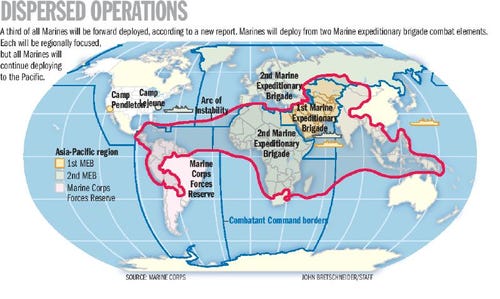 As the Corps hones its position as the nation's crisis response force, a new doctrine details how Marines will remain expeditionary through service-wide restructuring, forward deploying a third of all personnel and better integrating special operations forces.
As the Corps hones its position as the nation's crisis response force, a new doctrine details how Marines will remain expeditionary through service-wide restructuring, forward deploying a third of all personnel and better integrating special operations forces.
In fact, the recently released report, called "Expeditionary Force 21," pushes the Marine Corps in the direction of an agile force that mimics a kind of maritime service-wide special operations — snatching citizens from danger at embassies, securing coastal airstrips or bases, and even full-scale seizures of large swaths of land.
"The Navy, Air Force, and Army are optimized to dominate the sea, air, and land respectively," the report reasons, "the Marine Corps, by contrast, is not optimized to dominate any domain. Rather, the Marine Corps is optimized to be expeditionary — a strategically mobile force that is light enough to get to the crisis quickly, yet able to accomplish the mission or provide time and options prior to the arrival of additional forces."
Marines will be tasked with deploying to contested and non-contested areas faster than ever due to changing technology, said Maj. Scott Cuomo, director of IOC. Knowing what they're getting into before they land, whether by air or by sea, will be crucial, he said. New technology, like hand-held tablets, can help them get real-time updates on the situation on the ground while in transit, erasing much of the uncertainty Marines previously faced while en route.
There are varying degrees of "contested" ground. Expeditionary Force 21 contends that in some cases, quick deployment of Marines could potentially turn enemy armaments and firm bases into gains, while in other cases a combination of Air Sea battle doctrine will rely on naval assets to take out or soften these areas prior to Marine deployment.
As a result, the Corps will also look to strengthen its partnerships with the Navy, Coast Guard and special operations forces in order to operate more effectively in the maritime domain, the document states. Identifying areas they can integrate will result in more efficient application of limited naval resources, the document states.
That last part is key. As the Marine Corps emerges from two large land wars, it explicitly seeks to hand long-term land occupation duties to the Army, while also maintaining its relevance in those same large-scale operations as the proverbial boot against the door.
Expeditionary Force 21, unveiled in March, details the Marine Corps' 10-year course for a service that is "the right force in the right place at the right time," according to the foreword written by Commandant Gen. James Amos. With Marines being called on to be the first responders when humanitarian or manmade crises erupt, they'll continue to remain heavily engaged around the world, Amos wrote.
"The Marine Corps must reconfigure and refit to meet coming challenges," his foreword states. "Expeditionary Force 21 ... [is an] actionable plan and a disciplined process to shape and guide our capability and capacity decisions while respecting our country's very real need to regain budgetary discipline."
The 48-page plan focuses on organizational changes including an already planned reduction in a Marine expeditionary force headquarters element. It also lays out a plan to deploy Marine units — up to Marine expeditionary brigade level — withinseven days notice and capable to stay with existing supplies up to 25 days.
It won't change what Marines do at the core of their missions, just how they do it, the report states.
That includes a shift in thinking about the distance at which Marines might be called on to deal with a threat. That concept was on display in late-March when a company landing team made up of about 100 students attending the Infantry Officer Course in Quantico, Va., carried out a mock long-range raid as part of their training.
Cuomo said today's enemies have weapons they can fire from hundreds to thousands of miles away. That requires Marines to operate from greater distances in many situations, he added, and that can limit the size of the force they're able to put on the ground. It's important to train young officers to lead the types of mission they'll likely be called to conduct.
"Between 100 to 200 Marines will be the first wave in," Cuomo told Marine Corps Times. "And that force is going to have to fight by itself for — in what Expeditionary Force 21 lays out — potentially three to seven days that force is on the ground."
These initial Marines would potentially be responsible for — at times company by company — taking airstrips, naval bases, missile sites, and setting up small forward operating posts.
The mission, along with the time spent without direct support, requires more morally, mentally and physically capable Marines, Cuomo said. And Expeditionary Force 21 lays out the plan for operating in those more austere, forward-based conditions.
"The Expeditionary Force 21 just continues what Marines have been doing over our history, however it's saying that we're going to operate in a more distributed manner, a more dispersed nature," Cuomo said. "[That] is going to put greater responsibilities on the shoulders of Marines that get inserted off the back of a [MV-22B Osprey], for example."
Empowering the MEB
The Marine Corps will experiment with organizational changes to improve the ability to "command and control, deploy, employ, and sustain Marine Corps forces," the report states. Those changes will include shaving a Marine Expeditionary Force headquarters element, and regionally aligning units with certain parts of the world to which they can expect to deploy.That helps to enhance ongoing relationships, the report states, but it won't limit a unit from responding to a larger, global-scale contingency.
Cutting a MEF headquarters has been in the plan since the Corps began facing deep budgetary spending cuts. The II MEF headquarters at Camp Lejeune, N.C., will be absorbed by Marine Forces Command in Norfolk, Va., and it's expected to save a significant amount of money.
The MEF's division, wing and logistics group will remain at Lejeune, allowing 2nd Marine Expeditionary Brigade to reorganize with a more robust headquarters element. MEBs, the report states, will become the Corps' main effort in force deployments.
The end product will be a self-sustaining MEB that can deploy quickly, without drawing headquarters staff from the MEF. It would be able to support a Marine Expeditionary Unit, and if needed, function as a joint task force headquarters, or conduct large-scale humanitarian and disaster relief operations.
In order to help develop a MEBs capabilities, the Marine Corps plans to establish Joint Task Force-capable MEB combat elements that are regionally focused to meet the needs of combatant commanders around the world, the report states.
"Another characteristic is the ability to composite forward and merge rapidly deploying Marine Corps forces into a cohesive, agile force scaled to the mission. This will make the MEBs the centerpiece of an expeditionary force in readiness prepared for immediate, effective employment in any type of crisis or conflict."
Regionally focused deployments
Expeditionary Force 21 emphasizes the Corps' return to its amphibious roots because more than 80 percent of the world's population live within 100 miles of a coast — and that's increasing. So it's likely that Marines will deal with contingencies in those areas, particularly inside the so-called "arc of instability" that stretches across the globe, which includes coastal areas from Central and South America, across Africa and the Middle East to Southeast Asia.Over the next decade, Marines will likely be called on to conduct small-scale crisis relief in these regions, the report states. In order to meet coming challenges, the Corps needs to increase forward presence with a posture that ensures a third of active forces are "immediately available for employment."
The plan to make MEBs regionally focused can already be seen with several rotational units deployed across U.S. European and African Commands. Called the "single battalion concept," members of 8th Marines currently took over to form the headquarters element of Special-Purpose Marine Air-Ground Task Force Crisis Response, based out of Morón, Spain, with ground and logistics combat elements coming from 3rd Battalion, 8th Marines.
Most, if not all, of the remaining Marines with 3/8 comprise two rotational units that aim to enhance military partnerships in Eastern Europe and across Africa: Black Sea Rotational Force, based in Romania, and SPMAGTF Africa, based in Italy. An unspecified number also provides security reinforcement at the U.S. Embassy in Tripoli, Libya.
Other Marines based out of Camp Lejeune can expect to continue deploying to that area of the world. The 2nd MEB combat element will be oriented in that region "to support steady state activities and crisis response with three MAGTFs/[Marine expeditionary units] in direct support," the report states.
Here's a glimpse at how Marines will support combatant commands around the world:
U.S. European and Africa Commands
■ Members of 2nd MEB can expect to deploy here.
■ Marine Corps goals for this area of the world, according to the report, include placing a sea-based MAGTF in the region, with subordinate units that will conduct theater security cooperation and will be equipped to respond to crises. The elements can aggregate and respond to large-scale contingencies.
■ The Marines may be embarked on single amphibious ships or be based ashore.
U.S. Central Command
■ Members of 1st MEB out of California can expect to deploy here.
■ Goals for this region include a rotational amphibious ready group with a MEU tailored for crisis response. The Corps also plans to base a SPMAGTF based on the one deployed to Spain to deal with crises in Africa.
U.S. Southern Command
■ Members of Marine Corps Forces Reserve can expect to deploy here in small rotational teams.
■ Most missions will be based on theater security cooperation meant to enhance local drug interdiction efforts.
■ SPMAGTFs will be established when required for training exercises or events.
■ Crisis response in this region will be supported by 1st or 2nd MEB.
U.S. Pacific Command
■ Marines from across the Corps — to include the Reserve — will participate in the Unit Deployment Program.
■ There will be a forward-based ARG with a MEU augmented by additional 90-day sea-based MAGTF patrols and other MEUs moving through the region.
■ The report also lists a place for a SPMAGTF in Southeast Asia, and in two years, the Corps plans to have a full MAGTF based in Darwin, Australia.
U.S. Northern Command
■ Marines with 1st and 2nd MEBs, along with members of the Reserve, may be tasked to provide support to civil authorities in the case of a national emergency.
■ The Marine Corps will continue to support theater security cooperation activities within NORTHCOM, like that which it holds with Mexican marines.
■ A crisis response task force, composed of a reinforced infantry battalion task force, aviation and logistics enablers that can be fully deployed within eight to 12 hours of notification, will be based in the U.S.
New capabilities
Expeditionary Force 21 highlights the varying threats the Marine Corps could have to deal with around the world. From piracy along the West African coast to transnational organized crime in the Americas to squad-size teams evacuating diplomatic personnel from embassies. Each type of mission can pose different challenges, but Cuomo said Marines need to make sure they respond to them in a smart way — especially as they travel longer ranges to reach the sites."While they're different in the sense of what enemy capabilities might [or might not] be brought to the fight, they're similar in the long-range nature of those fights," Cuomo said. "We potentially now can come from hundreds of miles away, we can come from thousands of miles away given the V-22's aerial refueling capability, its range and its speed."
That differs greatly from its predecessor, the CH-46E Sea Knight helicopter, that could not be refueled while in the air and flew much slower, he said. And the same goes for amphibious landings, he added. The Marine Corps has always seized beachheads, but the speed and range at which they can do it now has changed their capabilities.
Those capabilities increase the speed of deployment, Cuomo said. That means Marines can deploy within three to four hours after an ambassador at a troubled embassy requests help. But with the Corps more dispersed, smaller units than usual might be the first to respond — and they could be there for days on end, Cuomo said.
In order to be successful in the Expeditionary Force 21 arena, the Marine Corps will have to rely on new technologies — whether high-speed boats or aircraft, drones, or incorporating tablets that can link troops to air surveillance assets through encrypted Wi-Fi to help provide intelligence or quickly allow them to request more ammunition and supplies.
The Marine Corps is still trying to work out a high-speed amphibious vehicle to quickly deliver infantry, munitions and armor to the battlefield, should the need arise.
"The truth is, the enemy has an increasing capability," said 2nd Lt. Travis Bird, a student at IOC who participated in the simulated long-range raid. "The enemy has smartphones, the enemy has technologies they're using against us, and I think the only way to continue to fight and win our battles is to become more versatile in our technologies ourselves. To neglect the opportunity ... would be a mistake and ultimately would lead to less combat effectiveness."
Brig. Gens. Matthew Glavy, assistant deputy commandant for aviation, and William Mullen, director of the Capabilities Development Directorate, are scheduled to discuss the new policy in more detail during this year's Sea-Air-Space exhibition and conference, hosted by the Navy League, on April 9. The discussion will be moderated by Lt. Gen. Kenneth Glueck, commanding general of Marine Corps Combat Development Command. They'll be joined by Rear Adm. Thomas Shannon, commander of Military Sealift Command.
______





